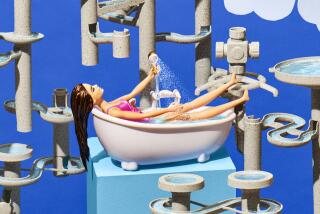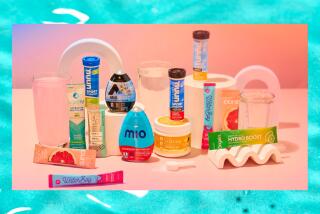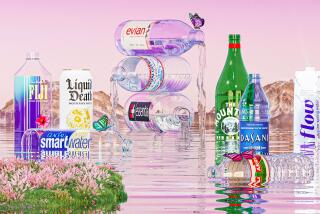Fortified Waters: Consider Them All Wet
- Share via
These days bottled water isn’t just simple H2O. Store shelves and vending machines are filling with so-called fitness waters, which may come packed with vitamins, minerals and herbal extracts. Others contain soluble fiber, fruit essence, caffeine or, thanks to modern science, an extra dose of oxygen.
What effect does all this have on our efforts to drink a healthy amount of water--usually five to eight glasses a day? Not an ounce.
“I know of no research that shows potential value of fitness waters over regular water,” says Douglas Casa, director of athletic training education at the University of Connecticut’s Human Performance Laboratory in Storrs.
And fitness waters can take a big gulp out of your budget. A 16-ounce bottle of Aquesse, for example, provides about 5 grams of soluble fiber--roughly what you’d get in two servings of oatmeal. But at $1.85, it costs at least three times more per serving.
Better to get most of your daily fluids the old-fashioned way: by drinking plain water, experts say. And don’t forget water-rich foods: Soups (hot or cold), veggies and fruit (especially watermelon, grapes, oranges, plums and grapefruit) also count and can help replace fluids lost during the sweltering days of summer. Water-rich foods are also valuable because they provide fiber as well as vitamins and minerals. Pennsylvania State University researcher Barbara Rolls and her colleagues have shown that these foods help quench thirst and make you feel full--a winning combination.
How much fluid is enough? That’s a question that vexes consumers and scientists. In fact, the National Academy of Sciences has convened an expert panel to review water recommendations. The group expects to report in the spring.
Lest you get parched waiting for their conclusions, the current advice is to take in 2 to 2.5 liters a day, says Michael Sawka, chief of thermal and mountain medicine at the Army Research Institute of Environmental Medicine in Natick, Mass. That works out to eight to 12 cups.
Before you feel like you’re drowning, know that you already get about half that liquid in the foods that you eat, particularly if you consume a healthy, well-balanced diet.
Coffee, tea, milk, juice and soda also count toward the total, but plain old H2O is the fluid of choice for the remaining five to eight glasses. “Water is as good as anything else for most situations,” says Sawka.
One exception to the water rule: If you exercise for at least an hour in hot weather, a sports drink may be a good idea, Sawka says. These beverages help improve recovery and can help reestablish your body fluids faster than water alone, he says.
If you do reach for a sports drink, pick one with about 110 milligrams of sodium and a touch of potassium per serving, Sawka says. And try to avoid drinks with added oxygen, carbonation, fructose or other sweeteners. The reason? The oxygen and carbonation can make you feel bloated, which may mean you don’t drink as much as you need. And the sweetener? As Sawka says: “It can give you a lot of gastrointestinal distress.”


